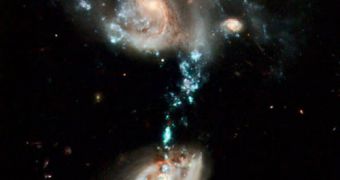The gravitational forces that occur between two colliding galaxies are always of impressive magnitude, but experts at NASA and the team managing the Hubble Space Telescope have never seen anything quite as astounding as the Arp 194 galactic formation. It's made of three galaxies, two of which can be seen at the top of the photo, and another one at the “bottom” of the image, in the background. Between Arp 194's two “poles,” the space observatory spotted a massive column of dust, gas and young, blue stars, spanning over 100,000 light-years.
“Resembling a pair of owl eyes, the two nuclei of the colliding galaxies can be seen in the process of merging at the upper left. The blue bridge looks like it connects to a third galaxy. In reality, the galaxy is in the background and not connected at all. Hubble's sharp view allows astronomers to try and visually sort out what are foreground and background objects when galaxies, superficially, appear to overlap,” a press release on Hubble's website says.
The image also clearly reveals the fact that the regular shapes the galaxies should have had have long since been distorted by their interactions. The “ellipses” and “barrels” are no longer visible, and astronomers hypothesize that this may have happened on account of a previous collision, maybe because another violent cosmic event altered the normal behavior of these galaxies.
Hubble has been observing such phenomena for a very long time, but its capabilities are starting to diminish, and to also become obsolete. However, NASA has to keep it up and running until 2015, if possible, when the new James Webb Space Telescope is completed. The American space agency is about to launch the fifth and final servicing mission to the orbit-based observatory, which will be carried out by the Atlantis space shuttle. The mission, STS-125, will take off in about two to three weeks, from the Kennedy Space Center, in Florida.
“This picture was issued to celebrate the 19th anniversary of the launch of the Hubble Space Telescope aboard the space shuttle Discovery in 1990. During the past 19 years, Hubble has made more than 880,000 observations and snapped over 570,000 images of 29,000 celestial objects,” the press release adds.

 14 DAY TRIAL //
14 DAY TRIAL //